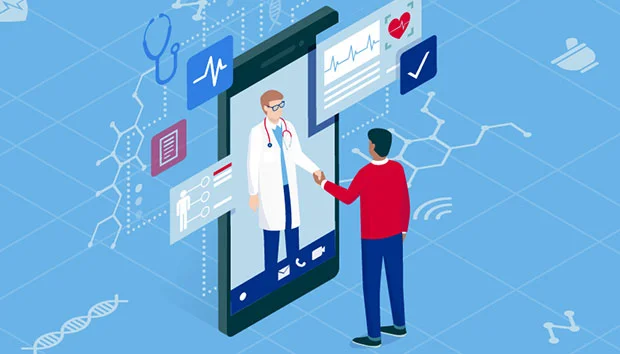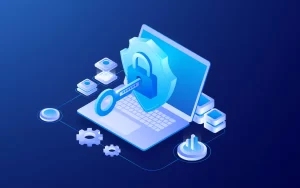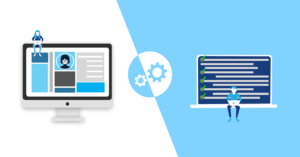Introduction
Technological advancements and digitalization have revolutionized every industry, and healthcare is no exception. Healthcare apps are on the rise as they improve overall patient engagement and experience, like online appointments, quick consultations, better collaboration, hassle-free payments, etc. Fortune business insights say the global mHealth apps market was around $38.9 billion in 2021 and is expected to grow $314.60 billion in 2028 with a CAGR (Compound Annual Growth Rate) of 34.8%.
Modern patients today expect more than just medical consultation. They want to collaborate with healthcare professionals, understand the diagnosis, and make informed decisions about their health, outweighing the pros and cons. In other words, the better patient engagement, the better clinical results. The National Library of Medicine emphasizes the importance of patient engagement as it facilitates patient satisfaction, better health outcomes, improved work efficiency, and an enhanced Return on Investments (ROI). Moreover, engaged patients are more likely to take charge of their health and seek medical attention on time, avoiding unwanted medical emergencies.
The Current State of Patient Engagement in Healthcare
Healthcare facilities are striving their best to provide optimal patient engagement. Here are some methodologies they follow:
- Educating patients: Healthcare providers provide patients with informative and educational materials like brochures, videos, and webinars illustrating health conditions, preventive measures, treatment options, etc. Many of us must have experienced ourselves while waiting in a healthcare facility.
- Online patient portals: Almost all healthcare centers have secure online platforms that allow patients to access their test results, medical records, and medication histories anytime. Thus, they can quickly refer to it without searching multiple files.
- Patient support groups: Often, people who share similar health conditions and symptoms come together and provide emotional support to each other. Many hospitals encourage such communities as patients need more moral help and medical backing.
- Telehealth: Telehealth enables patients to connect with medical professionals remotely through video conferencing, phone calls, and messages without visiting the healthcare center. Patients prefer it for the convenience of getting medical advice from professionals right from their homes. Though some developed countries have full-fledged telehealth, it has yet to be prevalent worldwide.
- Healthcare apps and wearable devices: These technologies and smart devices encourage patients to monitor their vitals like heart rate, blood pressure, oxygen levels, etc., and approach medical professionals faster and manage their health better.
Technology made patient engagement seamless in 2022, but healthcare professionals still face challenges in engaging patients.
- Patient’s lack of involvement: Some patients may not be motivated to take charge of their health, which makes it difficult for healthcare providers to engage them.
- Time constraints: Most healthcare providers are over-occupied with work and have limited time to spend with each patient, which makes it challenging to engage patients effectively.
- Lack of training: Some healthcare providers may not be trained to engage effectively with their patients.
- Limited access to technology: Though technology is a great tool that connects patients and doctors, not all patients have access to it. That is, again, a potential barrier for underprivileged patients who live in rural areas.
- Privacy concerns: Some patients may be reluctant to share their personal health details considering privacy, which makes it difficult for healthcare professionals to engage them.
The Role of Healthcare Application Development in Improving Patient Engagement
Healthcare application development involves building software applications to provide various healthcare services like medical research, patient care, medical information support, and managing administrative tasks. These applications can be designed for healthcare professionals, patients, or both. One can access these apps on various electronic devices like desktops, laptops, tablets, and smartphones. Thus, these apps facilitate healthcare on the go.
The healthcare app development process is often a long process that involves gathering requirements, design, development, testing, and deployment. Just like any other app, healthcare apps must have an easy-to-use interface, quick navigation, and seamless integration with other internal healthcare systems.
Benefits of healthcare application development for patient engagement
Healthcare apps can improve patient engagement and enhance their lives in the following ways:
- Patients can get healthcare services from anywhere.
- Patients can gain access to educational resources that help better manage their health conditions.
- Patients can connect with doctors readily through video conferencing.
- Patients can manage their health better with tools and other health metrics in the app.
- Patients can actively partner with healthcare providers and improve their health outcomes.
- Patients can make informed health decisions with personalized health recommendations from the app.
Examples of healthcare applications that have improved patient engagement
- Health Tap: Patients can post their questions on this app. A Doctor will respond within 24 hours. Live consultations with medical professionals and access to medical records, test results, and prescriptions are some benefits patients can enjoy with this app.
- Teladoc: Teladoc allows patients to connect with healthcare providers via video conferencing. The app allows patients to receive healthcare services from anywhere, aiding in improved patient engagement and satisfaction.
- Medisafe pill reminder: The app helps people stay on track with their medications by sending reminders.
Key Features of Healthcare Applications That Improve Patient Engagement
- Personalization of healthcare applications
Personalization is the key to any mobile app development, especially in a healthcare application. Identifying the needs, preferences, and problems of targeted individual patients and incorporating relevant features into your healthcare application will help you provide personalized healthcare services to your patients. You can take the help of technologies like Artificial Intelligence (AI) and predictive analysis to analyze large amounts of patient data like medical history and genetic information to identify patterns and predict potential health risks. That allows early intervention and prevention of diseases and derives effective treatment plans.
Additionally, the use of wearable technology helps monitor and track individual patient health data in real time, enabling personalized treatment interventions. Overall, personalization in healthcare applications can lead to better patient outcomes, improved patient engagement, and greater satisfaction with healthcare services.
- Communication features in healthcare applications
A healthcare application needs seamless communication features for optimal functioning.
- Instant messaging: It allows patients to communicate with healthcare providers in real time to schedule appointments, enquire about timings, verify medications, and any general communication.
- Video & voice calls: Video and voice calling enables patients to connect with healthcare professionals remotely. Patients can clarify their doubts and take appropriate medications and manage their health conditions without visiting the doctor’s place.
- Multimedia sharing: With this feature, patients can share their reports, like scans, X-rays, etc., within the app. Thus, doctors can make an accurate diagnosis of their health conditions and treat them accordingly.
- Reminders & notifications: Healthcare personnel can send reminders and notifications to patients, reminding their upcoming appointments, lab tests, and other schedules.
Communication features improve patient engagement and enhance the overall patient experience with that particular healthcare service provider.
- Integration of wearables and IoT devices
Wearables and IoT(Internet of Things) devices in healthcare applications will allow you to provide more personalized services. Below is the list of functionalities that you can
monitor by integrating wearable and IoT devices into your healthcare app.
- Monitor vitals: Wearables and IoT devices can help patients monitor their own vitals, like blood pressure, heart rate, etc. Doctors can assess the patient’s vitals remotely and adjust treatment plans accordingly.
- Track fitness: Wearables like smartwatches help people monitor their footsteps and activities. Thus, they can increase their activities to burn calories and stay fit.
- Medication reminders: Wearables can remind patients to take medication, water, etc. Thus, patients can manage their diseases better and live an active lifestyle.
- Personalized recommendations: Patients can access their health data, sleeping patterns, and activities, adjust their lifestyle and manage their health better.
Wearables and IoT devices give the patient more control over their health, reduce healthcare costs and improve the overall patient experience.
- Gamification of healthcare applications
Gamification in health and wellness apps is trending among patients of all ages. Gamification is nothing but including fun elements in the app, like giving points, coins, badges, stars, etc., as a reward to encourage patients to do some health-related tasks. Gamification increases patient engagement and helps stay motivated to reach their health goals. It also promotes healthy behavior among patients and yields better outcomes. Moreover, with gamified healthcare apps, you can collect patients’ data, like their behavior, preferences, and interests, and use it to offer personalized recommendations to them. Gamification is used in healthcare for various purposes, such as fitness and well-being, physiotherapy, chronic illness management, mental health, etc.
Best Practices for Healthcare Application Development to Improve Patient Engagement
- User-centered design principles
User-centered design is a practical approach emphasizing the importance of understanding users’ needs and building a user-friendly, easy-to-navigate app. No one will like to spend hours learning the features of the app. So, make the interface readily accessible to users with clear descriptions. Make all the options available on the app handy and easy to find. For instance, they should readily find search, menu, and other salient features that will help them take the next immediate action. Using short sentences and easy-to-understand words is one of the crucial elements of user-centered design.
Lastly, Healthcare apps often deal with sensitive personal information. Hence, it is vital to keep user data secure and private. Provide clear explanations of how user data is collected, stored, and used, and obtain user consent before collecting any data. Healthcare apps improve user engagement, satisfaction, and health outcomes with user-centered design principles.
- Ensuring the privacy and security of patient data
Patients often have to give their sensitive information to healthcare apps. Ensuring a secure app is crucial to protect patients’ data. Here are some ways to secure the app from data leakage.
- Educate your staff: Negligence can result in major data security breaches in the healthcare industry. Educating your employees and giving them the necessary knowledge of data security can prevent unwanted consequences.
- Implement access control: Not everyone in the firm needs access to all data. Set access controls and limit access to sensitive data. Let your employees access data only they need to perform their work. That way, you can prevent major data compromises.
- Data encryption: Encrypting sensitive data in transit and at rest ensures the data is protected, as it makes it difficult for attackers to decipher data even if they access it.
- Conduct regular risk assessments: Risk assessments help you identify potential threats and vulnerabilities in your healthcare organization. Thus, you can proactively identify and mitigate potential risks, avoiding data breaches and reputation damage.
- Regular data backups: Regular backups of data cannot be overlooked. Not only in case of data threats but a natural disaster or system failure can make data recovery difficult if you don’t have a backup.
- Continual updates and improvements of healthcare applications
The healthcare app development process does not end after its launch. It demands continual updates and improvements to match the evolving needs of patients, healthcare services and providers. Let’s discuss some of the best practices for updating and improving healthcare applications:
- Ask for user reviews: Keep asking for regular feedback from your users to understand their needs and the problems they face while using the app. Implementing the changes will help you improve your app and deliver a user-friendly experience.
- Stay updated with the latest trends and technologies: Trends change, and technology booms. Ensure your app is constantly updated so that it is compatible with all devices.
- Continuous testing: Keep testing the healthcare app for its performance, functionality, and usability. Apart from your testing team, you can invite a group of end users and indulge them in usability testing. Most bugs pop up during usability testing when the end user randomly clicks or operates something.
- Educate your users: Educate your users and provide them with training materials to better understand the features and functionality of the app. Keep updating the training material when a new feature or functionality is introduced to the healthcare app.
- Providing support and resources for patients
Providing support and resources for patients through a healthcare app is one of the best strategies to improve patient engagement. Here are some ideas to do so:
- Address their questions and concerns: Make the healthcare app more interactive and provide options for the patients to reach patient support. Let patients get their questions answered through chats within the app. The more reachable you are, the better the patient engagement.
- Alerts and notifications: Send push notifications through your healthcare app, reminding patients about upcoming healthcare events, camps, and more. Rather than marketing messages, send some valuable information that really benefits your patients. Let them know you care for them.
- Encourage online communities: Let patients connect with other patients within your app. That will create a sense of community, enabling patients with similar health conditions to connect and support each other.
Case Studies of Successful Healthcare Applications for Patient Engagement
Doctor on Demand solved the four main challenges that the telehealth industry faced in the past and rose to fame in a short time. First, the app educated the people that they can avail of telehealth services through their health insurance coverage provided by their employers. Thus, more and more Americans started utilizing telehealth services via the Doctor on Demand app. Second, it streamlined the right incentives for payers, like health plans and self-insured enterprises, encouraging people to use the app. Third, the app added more healthcare providers and offered a wide range of services, attracting diverse patients. Fourth, it overcame the complicated medical atmosphere by providing healthcare services via a mobile app.
Unique Features of Doctor on Demand
- The app connects the patients to physicians in 3 minutes.
- The app allows physicians to prescribe medications at the right pharmacies.
- The app provides easy access to the best local doctors, psychologists, and other healthcare professionals.
- The app connects patients with physicians licensed within the state, complying with medical regulations.
- The app accurately determines the location of the patient with the Google Maps platform and seamlessly connects the patient with a physician.
- The app allows patients to view the map of nearby pharmacies.
- The app saves time and lets patients pick up prescriptions at the pharmacy.
Future of Healthcare Application Development in Improving Patient Engagement
- Emerging trends in healthcare application development
- Internet of medical things (IoMT): IoMT is the network of internet-connected medical devices and healthcare applications used to better monitor and diagnose patients’ health conditions. With IoMT, doctors can monitor patients, collect their reports from various sources and treat them promptly without visiting them. Overall, IoMT improves healthcare quality by providing real-time medical assistance to patients regardless of location.
- Artificial Intelligence (AI): AI can process large amounts of patient data in the healthcare app and predict patient health conditions. Moreover, AI can automate most of the time-consuming admin work while reducing time and improving work efficiency.
- Blockchain: Blockchain improves data security due to its decentralized nature, enabling patients to share their medical records securely. It gives more control to patients over their medical records, improving privacy.
- Augmented Reality (AR): AR has the potential to revolutionize the healthcare system. AR can enhance the precision of robot-assisted surgery, provide better wound management, and elevate physiotherapy treatments, aiding better outcomes.
- Predictions for the future of healthcare application development and patient engagement
Healthcare apps will keep booming, and here are some predictions we might see in the coming years.
- AI-powered chatbots and virtual assistants — for better patient engagement and assistance.
- More telemedicine apps for various medical services — connecting diverse patients with concerned healthcare professionals.
- Personalized medical services — by gathering and analyzing patient medical data.
- Patients can proactively manage their health by making informed decisions about their health and wellness.
- Healthcare will become more digitized, like electronic health records, medical devices, and other systems. Thus, they can seamlessly integrate, avoiding any manual data entry.
Conclusion
Patients today do not prefer one-way communication with their healthcare providers anymore. They care for their health more than ever and want to partner with doctors to better understand their health conditions and make informed decisions for optimal health. Healthcare apps improve patient engagement by enabling patients to interact with healthcare professionals and take consultations online at their convenience. With technological advancements, healthcare app development is skyrocketing, bringing healthcare professionals a step closer to patients. Contact our Latent experts today to build your healthcare app.




